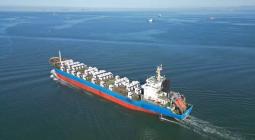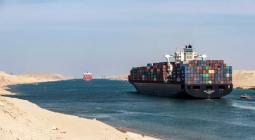Overall, many see natural gas as a temporary “bridge fuel” to aid the transition to zero-carbon fuels, but fewer than a third of shipping operators plan to use it in the next five years to avoid making what might turn out to be the wrong choice in a 20 to 30-year investment.
Methanol is popular but expensive.
Industry giant Maersk is already investing in “green” methanol, a climate-neutral fuel made from captured carbon dioxide and clean hydrogen (hydrogen produced using renewable energy with low to no emissions). Methanol can already be used in existing ships as it can be stored as a liquid at atmospheric temperature, and storage facilities are available at 88 of the world’s 100 largest ports.
However, the biggest obstacle to green methanol is sourcing its ingredients. The infrastructure to capture carbon dioxide and obtain hydrogen using renewable resources is not yet available at scale, leading to high costs. Unless incentives for growth are implemented, experts suggest other, more cost-effective fuels are likely to dominate the future market.
Ammonia and hydrogen are the best fuels long-term but will be slower to scale.
Ammonia — a renewable fuel made up of nitrogen and hydrogen — is currently one of the most promising solutions as it emits almost no carbon dioxide, has a high energy density and is relatively cheap compared to other zero-emissions fuels. However, using ammonia as shipping fuel involves safety hazards, primarily toxicity. Onboard and onshore staff must be specially trained and carry protective equipment, and vessels must be designed to a high level of safety to reduce the probability of leaks. This, along with the need to scale-up the production of green hydrogen, makes ammonia more costly than traditional fuels.
Hydrogen fuel is also increasingly seen as an important solution for decarbonizing shipping. If produced using renewable energy sources, hydrogen fuel burns with zero carbon emissions and water as the only byproduct. It also has approximately 3 times the energy density of heavy fuel oil and is non-toxic, colorless and odourless. However, hydrogen is a flammable and easily diffused gas; to use it as a fuel, crews must be specially trained and ships would need to implement costly infrastructure to store the hydrogen at cryogenic temperatures of -253 degrees C (-423degrees F) through pressurization. These safety concerns, as well as high retrofitting and operational costs, are deployment barriers shared with ammonia.
Biofuels and electric ships are helpful but limited in scope.
Biofuels and electricity are also being explored as alternatives to heavy fuel oil and are already seeing limited use when blended with other marine fuels.
Biofuels, which are made by converting biomass such as vegetable oils or animal fats into fuel, can be renewable and low in carbon emissions. However, their sustainability depends on the type of biomass and animal feedstock used to produce them. There are also ethical complications of cultivating resources for biomass where food could be grown instead. Significant environmental and economic barriers inhibit the large-scale adoption of biofuels, but there is increasing research into how they can help accelerate the low-carbon transition.
Electric battery packs and shoreside power are another zero-emission option for the global shipping industry. Given current infrastructure, electric options are only realistic for short-sea trades or small domestic ferries. However, they could increase if used in combination with other fuels; for example, in electric motors that could be charged from diesel-driven generators.
What Needs to Happen to Reach Net-zero Shipping Emissions?
There’s simply no way around it — before the shipping industry can transition to zero-carbon fuels, the generation of renewable energy must increase.
Producing fuels such as hydrogen, ammonia and methanol requires considerable amounts of energy, meaning these fuels can only mitigate overall emissions if that production energy is also decarbonized. For example, hydrogen fuel can be produced as a byproduct of fossil fuel refining, leading to significant GHG emissions and compromising its potential as a zero-carbon solution. Only 30% of the world’s energy is produced using renewables at present. While the clean energy transition is gaining momentum, it is not expected that the industry can produce enough zero-emissions fuel to reach net-zero targets by 2050 unless countries rapidly scale up renewable energy investment and deployment.
To truly align with the goals of the Paris Agreement, the shipping industry will also need stronger commitments than those set by the IMO’s 2023 strategy. This presents a major opportunity for shipping companies, national governments and other key players to show leadership on this issue. There has already been progress in this area with initiatives like the Green Shipping Challenge, launched by the U.S. and Norwegian governments at COP27 and supported by the Ocean Panel, which encourages governments, ports and companies to make commitments toward net zero.
Countries can implement policy measures to incentivize this transition. The European Union moved in 2022 to include emissions from shipping in its carbon market (the EU Emissions Trading System), which will charge vessels a fee for emissions and aims to encourage the sector to expedite the transition. More examples of leadership like this will be needed on a global scale to achieve net-zero. Campaigners have also called for a levy on GHG emissions from international shipping, from which proceeds would help fund climate solutions in the developing world. While many, including the World Bank and national governments, support this proposition, it seems unlikely to be agreed before 2027 at the earliest.
Finally, the transition will require a massive increase in funding for low-carbon fuels and infrastructure. The process of making alternative fuels commercially viable, safe and reliable to use on vessels, scaling them up and deploying them across the global shipping industry will be expensive; estimates say it will cost around $1-$1.4 trillion to achieve the industry’s decarbonization goals.
The sector already has access to some finance mechanisms — such as debt finance from the current signatories of the Poseidon Principles amounting to more than $185 billion — and large shipping companies are expected to increase low-carbon investments in the future. The IMO’s 2023 strategy also creates a business case for both increasing public and private investment and aligning new and existing finance, which can help drive national and regional policy. But the main challenge will be financing these solutions in time to meet the goals of the Paris Agreement.
Charting the Course to a Zero-carbon Future
While the transition to zero-carbon shipping may be daunting, it also presents a unique opportunity. Not only can the sector help curb climate change, but it can become a leader in climate innovation, helping other energy sectors reach their decarbonization goals through the development of low-carbon fuel infrastructure. This shift can also improve coastal air quality, reduce human health risks and premature death from shipping pollution, and create jobs associated with new fuel supply chains.
As pressure mounts, the industry must accelerate transformative actions, increase funding, and adopt strong policy frameworks to ensure it can deliver this critical transformation on time.






